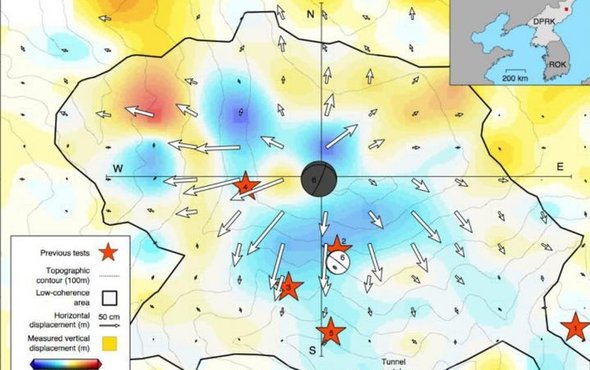(单词翻译:单击)
听力文本
This is Scientific American — 60-Second Science. I'm Christopher Intagliata.
North Korea has promised to close its underground nuclear test site at Mount Mantap later this month. Shortly thereafter, President Trump is set to meet North Korea's leader Kim Jong-un in Singapore.
Regardless of how that goes, there's a now an additional tool to investigate covert subterranean tests: radar. Specifically, a type called synthetic aperture radar, which works day and night, and through clouds.
Scientists already use seismic data in their nuclear detective work. "We use the kind of techniques that earthquake seismologists use to figure some aspect of what that explosion did." Roland Bürgmann, a geophysicist at University of California, Berkeley. He says they can also measure isotopes in the air, as well as optical images pre- and post-explosion.

Now Bürgmann and his team have used synthetic aperture radar data from German and Japanese satellites to gather more clues about North Korea's biggest blast, in September 2017. Comparing before and after scans of the test site, their analysis found that the mountain bulged a dozen feet in one direction, and sunk a foot and a half.
Using computational modeling, they then simulated what sort of blasts could have produced those movements. Their estimate: the blast was at least six times as strong as the bomb the U.S. dropped on Nagasaki in World War II. The details are in the journal Science.
"I think our study shows this is an especially valuable observation that can be thrown into the mix." When the U.S. and India launch their synthetic aperture radar satellite, called NISAR, in 2020, we'll have even more of this new kind of data. The hope is that no unauthorized nuclear tests will take place to be discovered.
Thanks for listening for Scientific American — 60-Second Science. I'm Christopher Intagliata.
参考译文
这里是科学美国人——60秒科学。我是克里斯托弗·因塔利亚塔。
朝鲜已承诺本月晚些时候关闭位于万塔山的地下核试验场。其后不久,特朗普总统将与朝鲜领导人金正恩在新加坡举行会谈。
无论事态如何发展,现在有一种额外工具来调查隐秘的的地下试验:雷达。具体来说,就是一种合成孔径雷达,它可以夜以继日地工作,还可以穿越云层工作。
科学家已经在核侦察工作中应用了地震数据。“我们用这种地震学家采用的技术来了解核爆炸的一些情况。”加州大学伯克利分校的地球物理学家罗兰·伯格曼说到。他表示他们还可以测量空气中的同位素以及爆炸前后的光学图像。
现在伯格曼和团队利用德国和日本卫星提供的全成孔径雷达数据,收集朝鲜最大爆炸的更多信息,该爆炸发生在2017年9月。通过对比爆炸前后的核试验场扫描图,他们分析发现,万塔山向一个方向隆起了12英尺,然后凹陷了 1英尺半。
随后他们用计算机建模,模拟哪种爆炸可以产生这些迁移。他们估计,该爆炸的威力至少是二战期间美国向长崎所投放原子弹的6倍。这项研究的具体内容发生在《科学》期刊上。
“我们的研究表明,这是特别有价值的观察结果,可以加入到相关研究成果之中。”当美国和印度在2020年发射合成孔径雷达卫星“NIDAR”时,我们将掌握更多此类数据。希望不会再发生未经授权的核试验。
谢谢大家收听科学美国人——60秒科学。我是克里斯托弗·因塔利亚塔。
译文为可可英语翻译,未经授权请勿转载!
重点讲解
重点讲解:
1. be set to do sth. 做好准备的;可能的;
According to most opinion polls, he is set to win a clear majority.
从大多数民意调查的结果来看,他很有可能以绝对多数票胜出。
2. regardless of 不顾;不管;不论;
The amount will be paid to everyone regardless of whether they have children or not.
不管有没有孩子,每个人都会得到相同的金额。
3. day and night 日日夜夜;夜以继日;
Chantal kept a fire burning day and night.
尚塔尔让一堆火日夜不熄地一直燃着。
4. take place (尤指在控制或组织下)发生,进行,举行;
Modern instruments show that about ninety percent of all earthquakes take place along a few lines in several places around the Earth.
现代技术手段显示,全球将近百分之九十的地震都发生在个别板块间的少数边界上。


